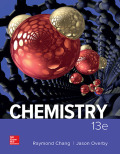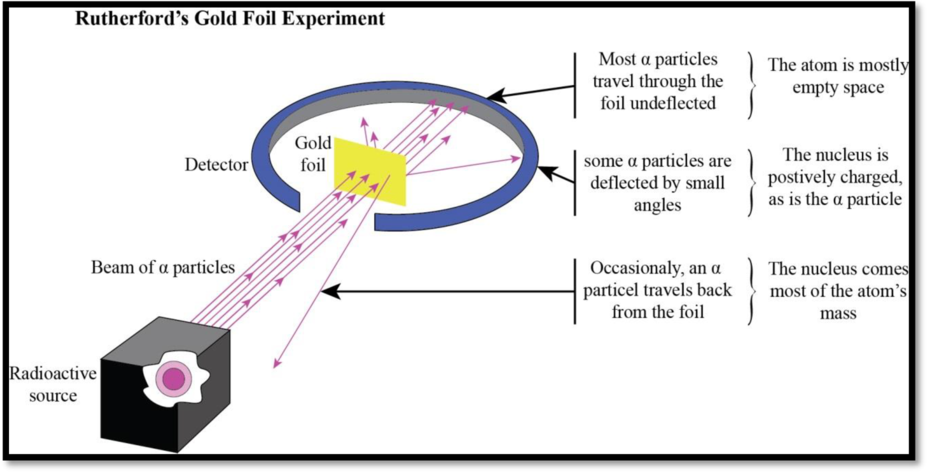
(a)
Interpretation:
Rutherford’s experiment has to be described and how it led to the structure of the atom should be explained. Also, how was he able to estimate the number of protons in a nucleus from the scattering of alpha particles should be explained.
Concept Introduction:
Atoms: Atoms consist of tiny particles called protons, neutrons and electrons. Proton and neutrons are present in the nucleus and the electron resides around the nucleus. The protons number will be same as the electrons count in the atom.
The
Where,
(a)
Explanation of Solution
The atom consists of concentrated mass called nucleus at the centre and surrounded by the electrons.
Every atom contains a nucleus in which all of its positive charge and most of its mass are concentrated is proven by the experiment.
Experiment:
Allowing alpha-particles (positively charged) to bombard with the gold foil, expected all the rays to pass through. In contrast, the rays are deflected with angles is observed.

Figure 1
Rutherford’s Experiment evidences about:
- The atom mostly consist of empty space (due to empty space most of the rays went through the foil).
- Very solid particles; presence of nucleus is revealed by the rays that bounced back.
- The nucleus consisting of positive charge is confirmed by the rays deflected at an angle. The similar charges have no attraction and are deflected away.
(b)
Interpretation:
The density of the nucleus
Concept Introduction:
Atoms: Atoms consist of tiny particles called protons, neutrons and electrons. Proton and neutrons are present in the nucleus and the electron resides around the nucleus. The protons number will be same as the electrons count in the atom.
The symbol of an element is
Where,
(b)
Explanation of Solution
Given:
Radius of the nucleus is
Mass of the nucleus is
Calculation of density of the nucleus.
Consider, the nucleus is spherical, and the volume of the nucleus is:
From which density of the nucleus is,
In order to calculate the density, the value of volume is must; which is calculated as shown above by considering the nucleus is spherical.
Calculation of density of space occupied by electrons in sodium atom.
To be required: The mass of
Mass of 11 electrons are:
The volume occupied by the electron is obtained by the differences between the volume of the atom and volume of nucleus.
The volume of atom is:
Conversion of pm to cm:
The volume occupied by the nucleus is significant compared to the space occupied by the atoms.
Hence, the required terms are sufficient to calculate the density of the electrons:
The density of the electrons is
Want to see more full solutions like this?
Chapter 2 Solutions
Chemistry
- Consider the reaction of the cyclopentanone derivative shown below. i) NaOCH2CH3 CH3CH2OH, 25°C ii) CH3!arrow_forwardWhat constitutes a 'reference material', and why does its utilization play a critical role in the chemical analysis of food products? Provide examples.arrow_forwardExplain what calibration is and why it is essential in relation to food analysis. Provide examples.arrow_forward
- The cobalt mu-hydroxide complex cobaltate(III) of potassium is a dinuclear complex. Correct?arrow_forwardThe cobalt mi-hydroxide complex cobaltate(III) of potassium is a dinuclear complex. Correct?arrow_forward3. Arrange the different acids in Exercise B # 2 from the strongest (1) to the weakest acid (10). 1. 2. (strongest) 3. 4. 5. 6. 7. 8. 9. 10 10. (weakest)arrow_forward
- Name Section Score Date EXERCISE B pH, pOH, pка, AND PKD CALCULATIONS 1. Complete the following table. Solution [H+] [OH-] PH РОН Nature of Solution A 2 x 10-8 M B 1 x 10-7 M C D 12.3 6.8 2. The following table contains the names, formulas, ka or pka for some common acids. Fill in the blanks in the table. (17 Points) Acid Name Formula Dissociation reaction Ka pka Phosphoric acid H₂PO₁ H3PO4 H++ H₂PO 7.08 x 10-3 Dihydrogen H₂PO H₂PO H+ HPO 6.31 x 10-6 phosphate Hydrogen HPO₁ 12.4 phosphate Carbonic acid H2CO3 Hydrogen HCO 6.35 10.3 carbonate or bicarbonate Acetic acid CH,COOH 4.76 Lactic acid CH₂CHOH- COOH 1.38 x 10 Ammonium NH 5.63 x 10-10 Phenol CH₂OH 1 x 10-10 Protonated form CH3NH3* 3.16 x 10-11 of methylaminearrow_forwardIndicate whether it is true that Co(III) complexes are very stable.arrow_forwardMnO2 acts as an oxidant in the chlorine synthesis reaction.arrow_forward
- In Potassium mu-dihydroxydicobaltate (III) tetraoxalate K4[Co2(C2O4)4(OH)2], indicate whether the OH ligand type is bidentate.arrow_forwardImagine an electrochemical cell based on these two half reactions with electrolyte concentrations as given below: Oxidation: Pb(s) → Pb2+(aq, 0.10 M) + 2 e– Reduction: MnO4–(aq, 1.50 M) + 4 H+(aq, 2.0 M) + 3 e– → MnO2(s) + 2 H2O(l) Calculate Ecell (assuming temperature is standard 25 °C).arrow_forward: ☐ + Draw the Fischer projection of the most common naturally-occurring form of aspartate, with the acid group at the top and the side chain at the bottom. Important: be sure your structure shows the molecule as it would exist at physiological pH. Click and drag to start drawing a structure. ✓arrow_forward
 Chemistry: The Molecular ScienceChemistryISBN:9781285199047Author:John W. Moore, Conrad L. StanitskiPublisher:Cengage Learning
Chemistry: The Molecular ScienceChemistryISBN:9781285199047Author:John W. Moore, Conrad L. StanitskiPublisher:Cengage Learning Introduction to General, Organic and BiochemistryChemistryISBN:9781285869759Author:Frederick A. Bettelheim, William H. Brown, Mary K. Campbell, Shawn O. Farrell, Omar TorresPublisher:Cengage Learning
Introduction to General, Organic and BiochemistryChemistryISBN:9781285869759Author:Frederick A. Bettelheim, William H. Brown, Mary K. Campbell, Shawn O. Farrell, Omar TorresPublisher:Cengage Learning Chemistry: Principles and ReactionsChemistryISBN:9781305079373Author:William L. Masterton, Cecile N. HurleyPublisher:Cengage Learning
Chemistry: Principles and ReactionsChemistryISBN:9781305079373Author:William L. Masterton, Cecile N. HurleyPublisher:Cengage Learning Introductory Chemistry: A FoundationChemistryISBN:9781337399425Author:Steven S. Zumdahl, Donald J. DeCostePublisher:Cengage Learning
Introductory Chemistry: A FoundationChemistryISBN:9781337399425Author:Steven S. Zumdahl, Donald J. DeCostePublisher:Cengage Learning Chemistry & Chemical ReactivityChemistryISBN:9781337399074Author:John C. Kotz, Paul M. Treichel, John Townsend, David TreichelPublisher:Cengage Learning
Chemistry & Chemical ReactivityChemistryISBN:9781337399074Author:John C. Kotz, Paul M. Treichel, John Townsend, David TreichelPublisher:Cengage Learning Chemistry & Chemical ReactivityChemistryISBN:9781133949640Author:John C. Kotz, Paul M. Treichel, John Townsend, David TreichelPublisher:Cengage Learning
Chemistry & Chemical ReactivityChemistryISBN:9781133949640Author:John C. Kotz, Paul M. Treichel, John Townsend, David TreichelPublisher:Cengage Learning





